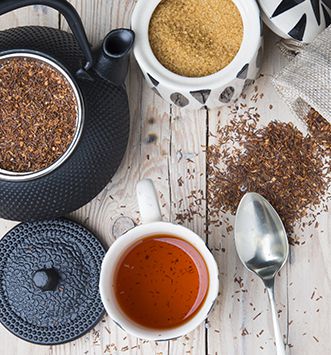
Rooibos, commonly incorrectly called red tea, is a beverage originating from South Africa. It is traditionally consumed with milk, but is also excellent plain. Rooibos tea is used in herbal teas that are appealing for their delicate flavors and the total absence of caffeine in their composition.
Organic red tea is incorrectly called "tea" since it contains no theine at all. This is actually an advantage since it can be consumed at any time of the day. It remains accessible to all people who are advised against caffeine (for example pregnant women). Discover in this
Red tea, closer to herbal tea than tea
The term "red tea" gives a misinterpretation of what rooibos really is and leads to confusion. In reality, rooibos from Aspalathus linearis has nothing in common with tea which comes from a shrub called Camellia sinensis. It differs from tea by its low tannin content and the total absence of caffeine in its composition. For this reason, rooibos should actually be closer to herbal teas rather than teas.
If it's called red tea, it's only as a shortcut but also because once infused, this beverage is red. You should know that rooibos comes in an infinite variety of flavors, just like tea. Its preparation is quite similar, which is why confusion is frequent. If you don't know rooibos, know that it's a very good alternative to tea if you want to consume a hot drink in the late afternoon or evening, without experiencing the stimulating and exciting effects. This famous red tea simply infuses in hot water.
Red tea, a characteristic flavor dominated by hazelnut
In terms of taste, African red rooibos tea again has little in common with tea. It has no bitterness even if you let it steep for a long time. On the contrary, red rooibos tea is naturally sweet and characterized by a delicate hazelnut flavor. It's a very mild drink that allows for creating gourmet blends by combining it with vanilla, fruits, or flowers. It's also used in relaxing or digestive blends. And since it contains no caffeine, rooibos can be consumed throughout the day.
Red tea exists in a wide range of flavors, to suit all desires and tastes. Traditionally, it is consumed in South Africa with milk and sugar. But since its natural taste is already slightly sweet, you can very well avoid adding any. This makes it a drink also suitable as part of a diet! Rooibos can be consumed as is or mixed with other flavors to create unique and original blends. For example, it pairs perfectly with fruits like orange or apple. Did you also know that it can enhance a dessert?
What is rooibos?
Once oxidized and dried, the Aspalathus linearis leaves form red needles of varying lengths. This is what we call red tea or rooibos. This delicious drink comes straight from South Africa, the only place where these famous plants are grown. Aspalathus Linearis is cultivated on medium-altitude plantations.
Naturally rich in antioxidants, rooibos is, like green tea or black tea, an excellent health ally. Slightly fermented, the leaves are presented in fine pieces, to be infused in hot water. Rooibos can then be enjoyed hot or cold, according to your preferences. And even in the evening, which makes it an ideal drink for those who fear insomnia related to caffeine!
Traditional red rooibos, an age-old beverage
Red rooibos has been consumed for centuries by indigenous people who attribute many virtues to it. This age-old drink is the traditional South African beverage.
Organic red rooibos tea is harvested during the first three months of the year: when it's summer in South Africa. You should know that the plant lives an average of seven years and it takes a year and a half for the first harvest. The harvested leaves are then slightly moistened and oxidize for 8 to 24 hours. It's during this step that they take on their characteristic orange-red color. The leaves then dry in the sun before being sterilized and packaged, before arriving in your cup!
Green rooibos with enhanced antioxidant content
Newly arrived, green rooibos is actually a rooibos that has not undergone any oxidation. Its flavor is different, but it is also richer in antioxidants.
Like tea, rooibos comes in different varieties. Recently arrived on the market, green rooibos is attracting more and more followers. It is an unfermented dried rooibos, which offers increased benefits. The harvest is done in the same way. However, green rooibos is not oxidized and therefore dries without adding water. Its antioxidant content is much higher, making it an ideal health ally. Its taste is more bitter and tangy, but it offers more health benefits.
Honeybush: a close cousin of rooibos
Honeybush is a cousin of rooibos that also belongs to the Fabaceae family. It has a characteristic honey taste which gives it the name Heuningbos in Afrikaans, which literally means "honey bush".
Less known than rooibos, honeybush also has super powers. This slightly honey-flavored theine-free infusion is characterized by digestive, calming, and antioxidant qualities. Honeybush is also very rich in trace elements and minerals. Good news: its virtues are numerous. This drink helps reduce the unwanted effects of menopause, eliminates free radicals from our cells, and has a beneficial effect on aging.